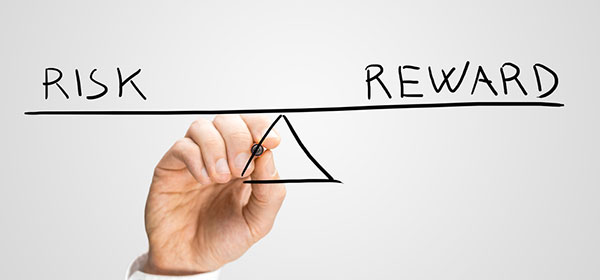Ask a room full of people whether they are confident in their ability to handle money, and the answer may well be yes. Unfortunately, rather than proving their skills, the answer may be an indication that they simply don’t know what they don’t know. The main problem is that when deciding where to place their money, few investors take risk and return into account. This is a sad state of affairs, because the two are irrevocably entwined, and an understanding of them is fundamental if you are going to be money smart.
First, understand that it is impossible to find a risk-free strategy. If you leave your money in the bank, you could suffer low returns with the very strong chance that you’ll live longer than your money, because every year its purchasing power will be diminished by inflation. Yet, if you put it in growth assets, such as property and shares, you leave yourself open to capital losses if you make the wrong choices or try to redeem when the market is down. It pays to remember the adage, ‘whenever there is a chance of capital gain, there is a chance of capital loss’.
You might have heard the old saying, ‘the higher the return, the higher the risk’, and you probably understand that higher returns mean you increase the chance of losing your nest egg. True. The people who invested their life savings in companies such as Westpoint and Estate Mortgage are proof of that, but to make it more confusing, here’s another saying: ‘the higher the risk, the higher the return’. No, it’s not a misquoting of the original saying, it’s just as true, but refers to a different kind of risk.
In investment jargon the word ‘risk’ means the degree of volatility of market movement that is associated with an investment. To put it simply, the more the value of an asset fluctuates, the riskier it is said to be. By this definition, cash is a ‘riskless’ asset because $1000 in the bank today should still be $1000 tomorrow, even if the property and share markets tumble. In contrast, you can be certain that the value of your share-based investments will vary from day to day, but, provided they are well chosen, you will achieve better returns over the long haul to compensate you for the increased risk or volatility.
A geared share trust is a great example. You will get higher returns than the market with a geared share fund because the internal gearing magnifies the gains – the downside is that you will suffer higher losses when the market falls, as they are magnified too. This makes geared funds a good investment for younger investors who have a long timeframe in mind, and a mindset that can handle the roller coaster ride these funds can give.
The lesson in all this is that time is the crucial element when considering where to invest those hard-earned dollars. If you believe you will need to withdraw the money in less than three years, you should stick with safe interest-bearing accounts, such as those offered online by the major banking institutions. They give certainty and no chance of loss.
However, if you are in it for the longer haul, you need to understand the risk–reward concept, because there is no doubt that ‘risky’ investments, such as quality shares, will give the best returns over time.
Think about Jack and Jill who are aged 40 and are saving for their retirement. They decide they will need an income of $40,000 a year in today’s dollars. Jack is an inexperienced and very cautious investor, and is so risk averse that even on optimistic forecasts his superannuation will earn six per cent per annum both before and after retirement. Jill understands the risk–return trade-off, and chooses a portfolio that is heavily weighted towards shares – her expected return is nine per cent per annum.
If inflation averages three per cent per annum, Jack will need to accumulate $1.49 million at age 65. This will require monthly contributions of $2147 to superannuation, which is probably well above his capabilities. Because Jill’s investment strategy will provide a higher return, she needs to accumulate only $1.114 million, and has to invest just $994 a month to get there.
This is a graphic illustration of the importance of understanding the risk–return trade-off. As Jill is prepared to accept greater volatility, she has to contribute far less to her superannuation during her working life – consequently, she has more money to spend out of each pay, while at the same time knowing her future is secure.
Noel Whittaker is the author of Making Money Made Simple and numerous other books on personal finance. His advice is general in nature and readers should seek their own professional advice before making any financial decisions.
Related articles:
Common investment mistakes
Is property a good investment?
Do your investments pass the test

